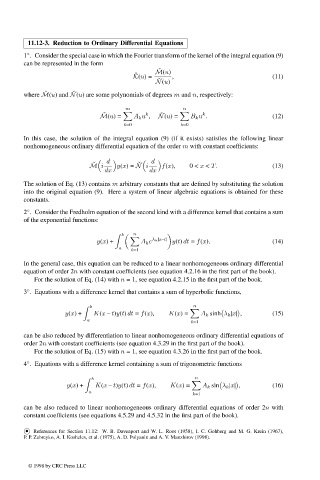Page 594 - Handbook Of Integral Equations
P. 594
11.12-3. Reduction to Ordinary Differential Equations
◦
1 . Consider the special case in which the Fourier transform of the kernel of the integral equation (9)
can be represented in the form
ˇ
M(u)
ˇ
K(u)= , (11)
ˇ
N(u)
ˇ
ˇ
where M(u) and N(u) are some polynomials of degrees m and n, respectively:
m n
k k
ˇ
ˇ
M(u)= A k u , N(u)= B k u . (12)
k=0 k=0
In this case, the solution of the integral equation (9) (if it exists) satisfies the following linear
nonhomogeneous ordinary differential equation of the order m with constant coefficients:
d d
ˇ
ˇ
M i y(x)= N i f(x), 0 < x < T. (13)
dx dx
The solution of Eq. (13) contains m arbitrary constants that are defined by substituting the solution
into the original equation (9). Here a system of linear algebraic equations is obtained for these
constants.
2 . Consider the Fredholm equation of the second kind with a difference kernel that contains a sum
◦
of the exponential functions:
n
λ k |x–t|
b
y(x)+ A k e y(t) dt = f(x). (14)
a
k=1
In the general case, this equation can be reduced to a linear nonhomogeneous ordinary differential
equation of order 2n with constant coefficients (see equation 4.2.16 in the first part of the book).
For the solution of Eq. (14) with n = 1, see equation 4.2.15 in the first part of the book.
3 . Equations with a difference kernel that contains a sum of hyperbolic functions,
◦
b n
y(x)+ K(x – t)y(t) dt = f(x), K(x)= A k sinh λ k |x| , (15)
a k=1
can be also reduced by differentiation to linear nonhomogeneous ordinary differential equations of
order 2n with constant coefficients (see equation 4.3.29 in the first part of the book).
For the solution of Eq. (15) with n = 1, see equation 4.3.26 in the first part of the book.
◦
4 . Equations with a difference kernel containing a sum of trigonometric functions
b
n
y(x)+ K(x – t)y(t) dt = f(x), K(x)= A k sin λ k |x| , (16)
a
k=1
can be also reduced to linear nonhomogeneous ordinary differential equations of order 2n with
constant coefficients (see equations 4.5.29 and 4.5.32 in the first part of the book).
•
References for Section 11.12: W. B. Davenport and W. L. Root (1958), I. C. Gohberg and M. G. Krein (1967),
P. P. Zabreyko, A. I. Koshelev, et al. (1975), A. D. Polyanin and A. V. Manzhirov (1998).
© 1998 by CRC Press LLC
© 1998 by CRC Press LLC
Page 577

